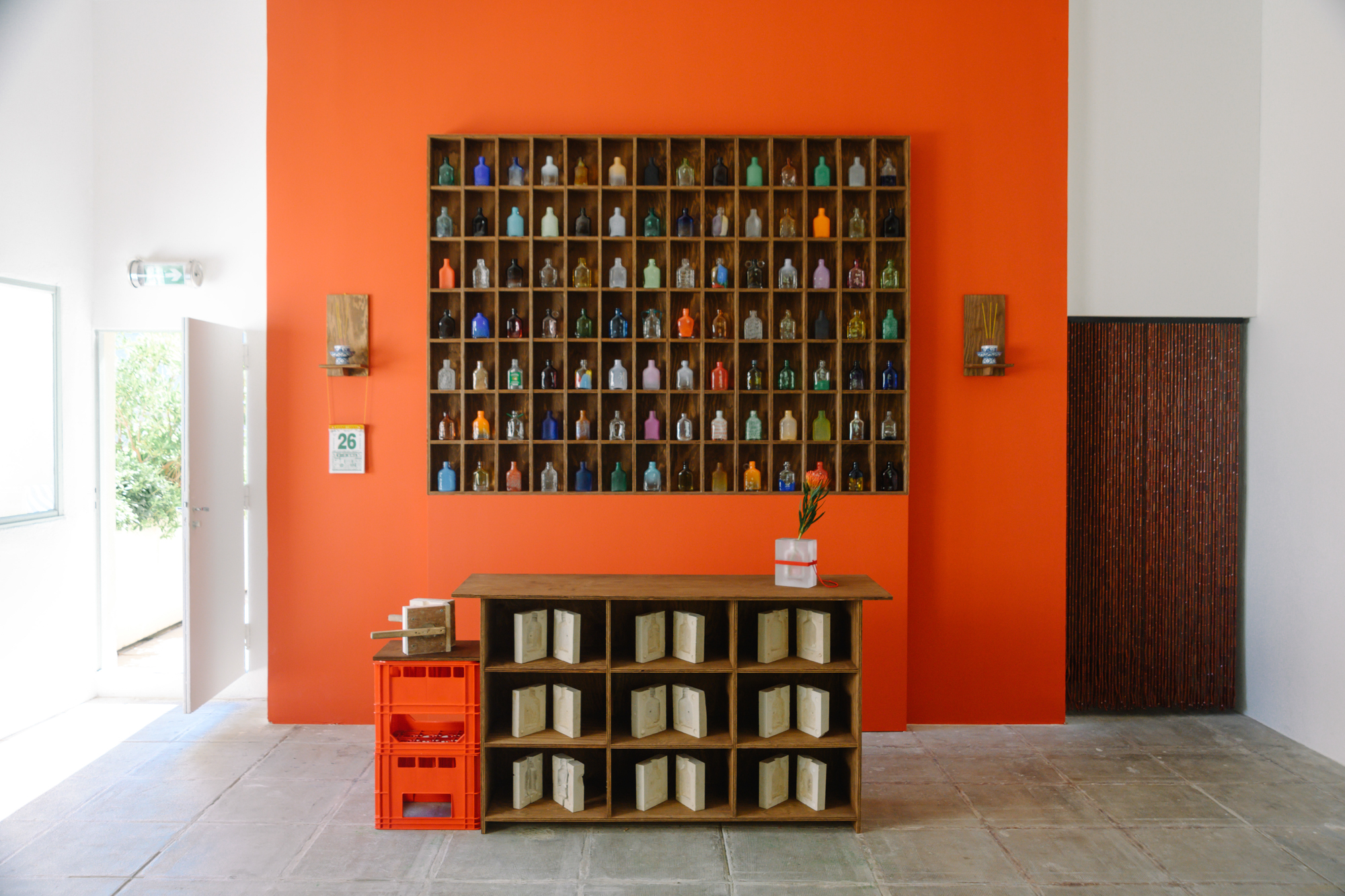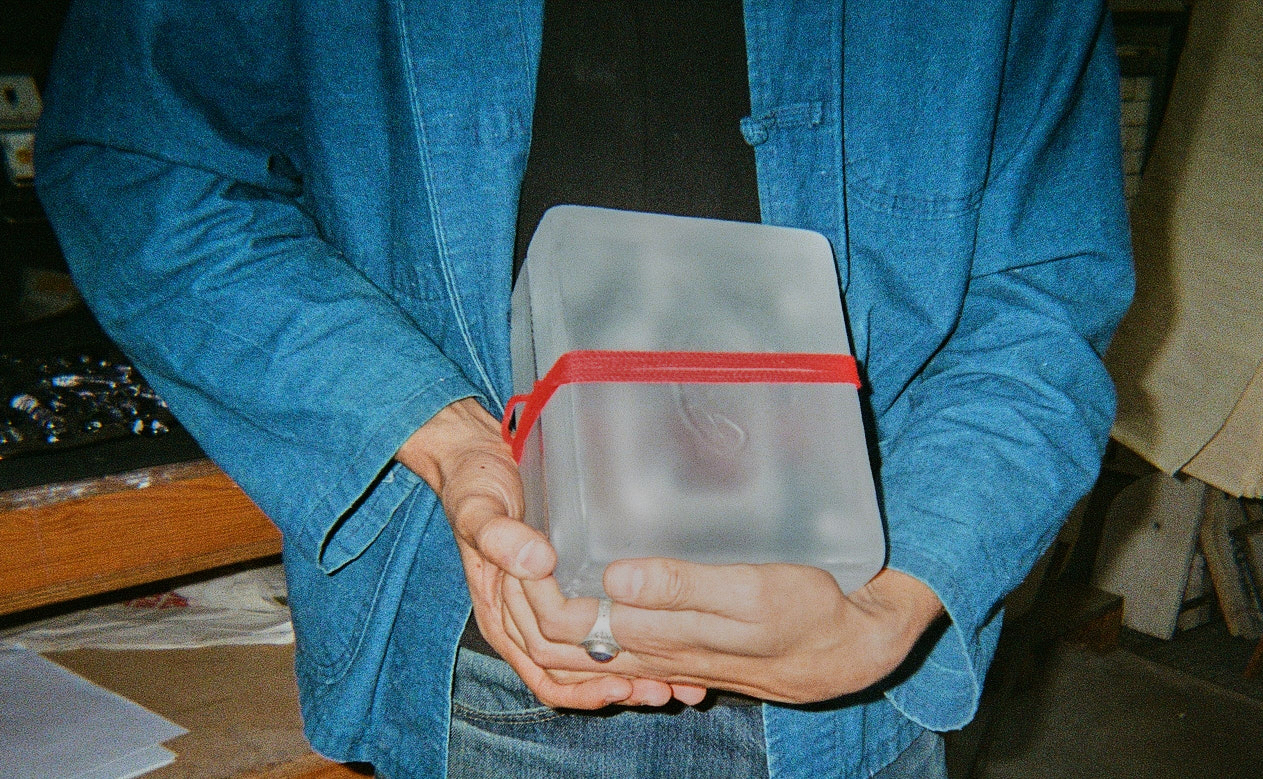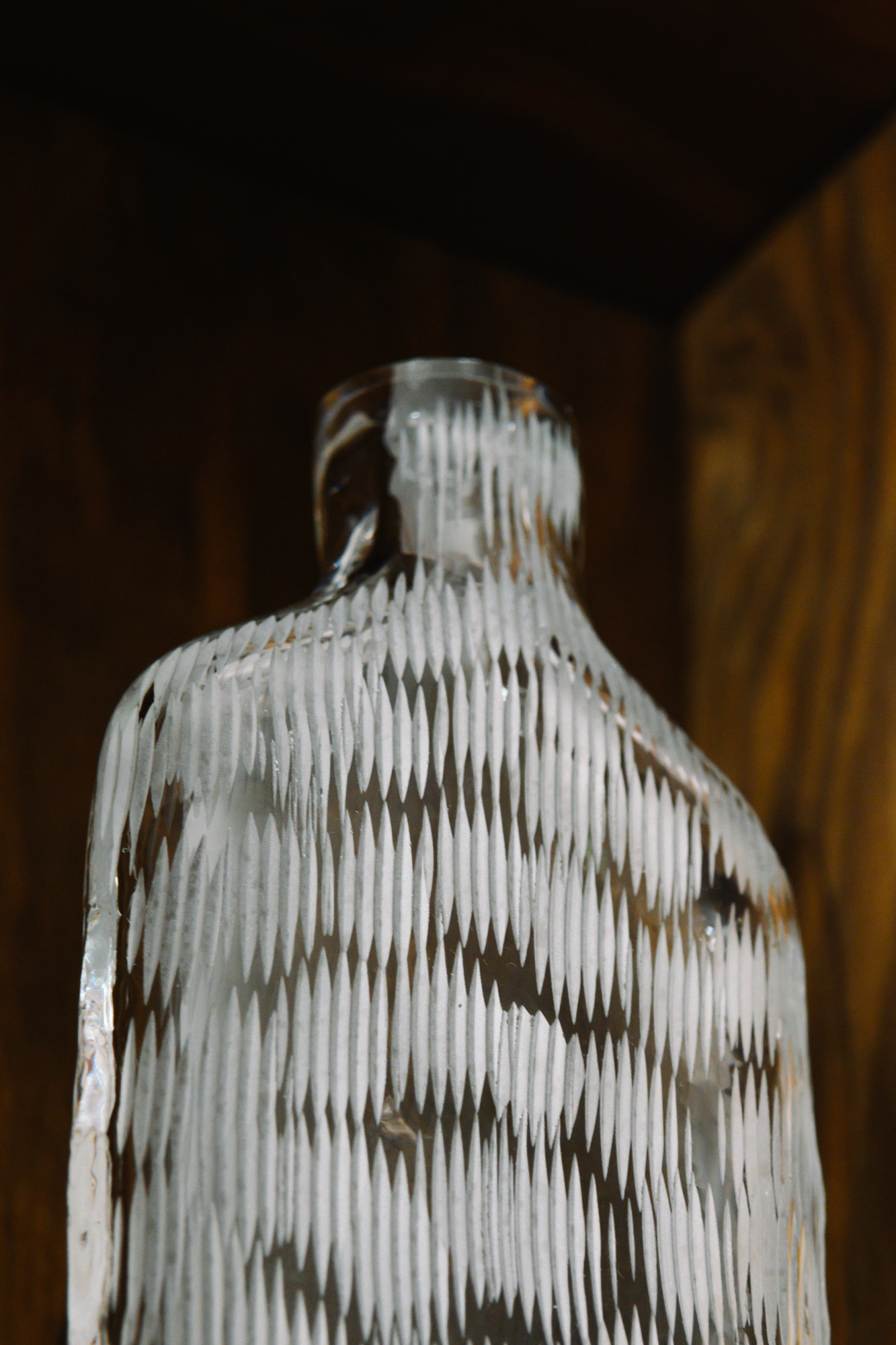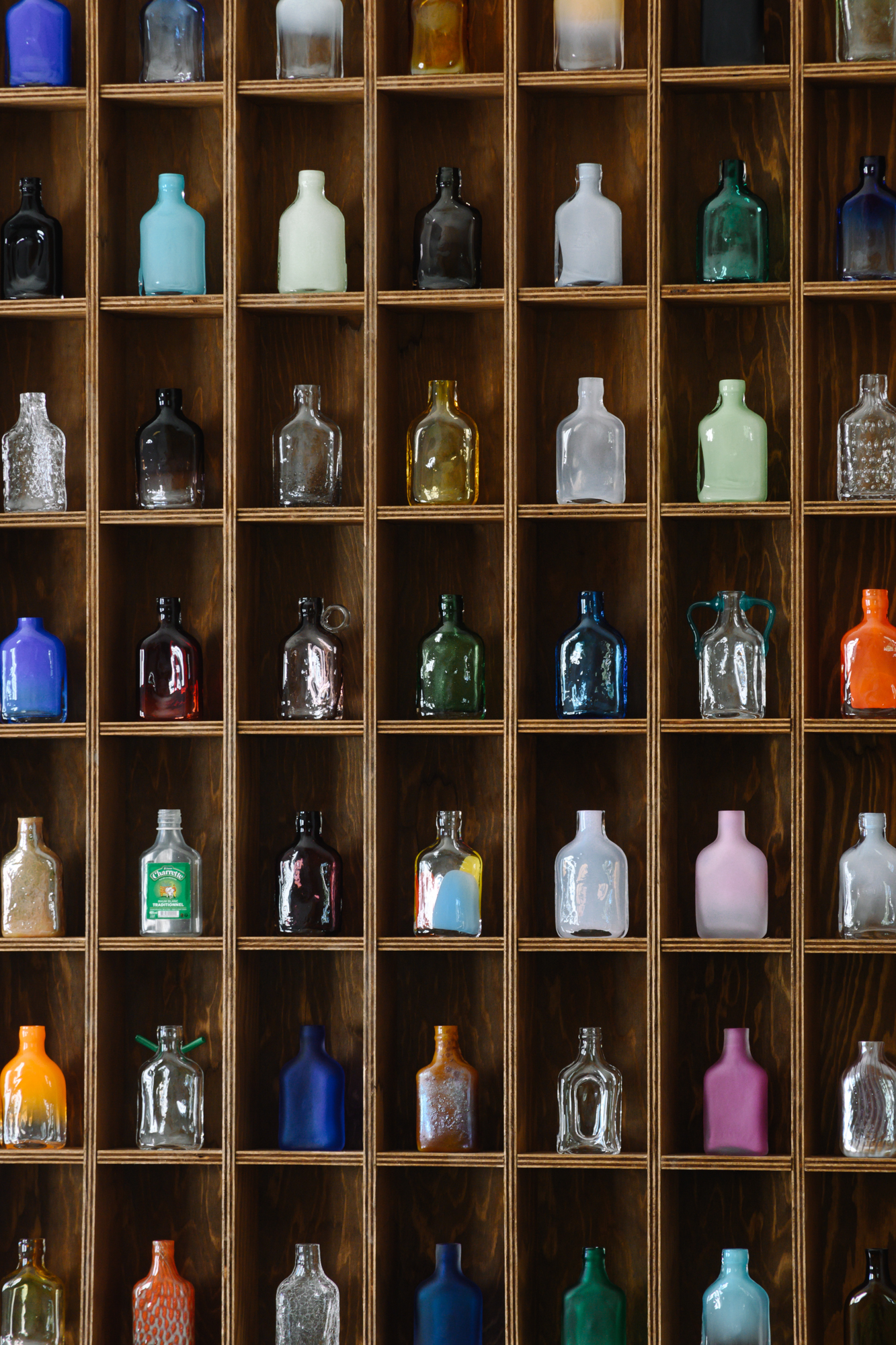villa Noailles, Hyères, France
June 28 – September 1st, 2024
🎉 Opening: June 27
Solo-exhibition of Yassine Ben Abdallah’s works organized by the Villa Noailles, in partnership with the Cirva

Yassine Ben Abdallah’s solo-exhibition view of À l’ombre de l’Empire, villa Noailles, Hyères, France, June 28 – September 1st, 2024.
© Yassine Ben Abdallah, photo © Camille Lemonnier / villa Noailles
Pile plate, Vase Varangue and Ombre blanche tell a story of movement, creolization processes, ghosts, oppression, reinterpretation and invisible but active presences. These works evoke the aftermath of the colonial world, shaped by domination and dehumanisation, exploitation, and misery, but whose hegemony is never absolute because it comes up against resistance, derivations, flight, and reappropriation.
Rum is symbolised here by the Pile plate, the name given to a bottle produced in 1988 with an alcohol content of 49%. Celebrated on La Reunion Island by the Saga du Rhum, a “tourist and cultural educational establishment,” rum is rather the emblem of the slave plantation world in the past and of the big capitalist corporations today. The sugar cane plantations it comes from were the justification for enslavement, impoverishing the land and destroying the environment. Rum was a weapon of colonial destruction of souls and bodies. By transforming this instrument of oppression into an indispensable and central element to the Afro-Malagasy rituals of their enslaved ancestors who kept fleeing the plantation, the people of La Reunion Island have proved the power of undisciplined popular practices. The artist is showcasing these paradoxes.
Vase Varangue and Ombre blanche are both based on the technique of porcelain, an art known to the Chinese since the seventh century, which ignited the imagination of the crowned heads of Europe when Marco Polo brought it back from his trip to China in the thirteenth century. It wasn’t until the eighteenth century that Europe discovered the secret of the white, fine, and translucent ceramic technique, that has since become an object of desire, a collector’s item, a wedding or diplomatic gift.
With Vase Varangue, Yassine Ben Abdallah brings into dialogue two techniques that are opposed by a class hierarchy: the popular craft of vacoa weaving and the art craft of porcelain, and two spaces: the veranda, this outdoor living room in the white Creole large houses where porcelain services were a mark of social and racial status, and the backyard where vacoa objects were woven, an art practised by working-class women. Two materials, one is mineral and fragile, the other is plant and solid. Two colours, white, the sign of purity and brown of impurity, according to the racial classification of the West. Two clashing worlds, marked by the social and racial inequality that defines them, and the liminal space that brings them into contact. The world of vacoa wickerwork both cuts and holds the world of porcelain, highlighting what is often invisible, the contribution of non-European peoples to the “white” world.
It was not uncommon to find representations of enslaved people on French crockery – sugar bowls, soup tureens, plates, and coffee cups. Soup could be poured over black people in chains against a backdrop of sugar cane fields; coffee could be served with a sugar bowl honouring slavery, slavery that made it possible to access a much-desired commodity. A crime against humanity was thereby normalised. As Yassine Ben Abdallah discovered this racism education through tableware, in other words through everyday and family objects, he sought to show how the visible and the invisible are shaped. Ombre blanche is a replica of the Clermont vase, often used as a diplomatic gift because it stands as a symbol of French excellence, combined with the Diane plate, one of the pieces in the Élysée dinner service. Inside this translucent porcelain, Yassine Ben Abdallah has had engraved racist figurines that adorned the crockery of the bourgeoisie. To see them, you would need break the vase. The artist calls on you to understand that what Europe would like to hide – its responsibility for centuries of slave trade and colonial slavery – is there, just beneath the surface. No need to look far, you just need to learn anew to look at what lies before your eyes.
Through these three works, Yassine Ben Abdallah subtly questions what we are ready to see, the underside of things that we just do not have to be afraid to uncover.
— Françoise Vergès. An authoress, feminist and anti-racist, Françoise Vergès is the authoress of Programme de désordre absolu. Décoloniser le musée (la Fabrique éditions, 2023).
—
The glass works presented in the exhibition were created as part of a research residency at the Cirva.
June 28 – September 1st, 2024
Villa Noailles
Montée de Noailles, 83400 Hyères, France
🌍 festival Design Parade Hyères, à la villa Noailles
🌍 Yassine Ben Abdallah
👉 En résidence au Cirva : Yassine Ben Abdallah

Souleymane Bachir Diaw, Yassine Ben Abdallah at the Cirva, 2024.
© Souleymane Bachir Diaw

Yassine Ben Abdallah, Pile Plate (detail), 2024, production / realization Cirva, Marseille. Yassine Ben Abdallah’s solo-exhibition view of À l’ombre de l’Empire, villa Noailles, Hyères, France, June 28 – September 1st, 2024.
© Yassine Ben Abdallah, photo © Camille Lemonnier / villa Noailles

Yassine Ben Abdallah, researches for Vase Pile Plate, 2024, production / realization Cirva, Marseille. Yassine Ben Abdallah’s solo-exhibition view of À l’ombre de l’Empire, villa Noailles, Hyères, France, June 28 – September 1st, 2024.
© Yassine Ben Abdallah, photo © Camille Lemonnier / villa Noailles

Yassine Ben Abdallah, Pile Plate, 2024, production / realization Cirva, Marseille. Yassine Ben Abdallah’s solo-exhibition view of À l’ombre de l’Empire, villa Noailles, Hyères, France, June 28 – September 1st, 2024.
© Yassine Ben Abdallah, photo © Camille Lemonnier / villa Noailles